 Technology peripherals
Technology peripherals
 AI
AI
 True Quantum Speed Reading: Breaking through the limit of GPT-4 that can only understand 50 pages of text at a time, new research extends to millions of tokens
True Quantum Speed Reading: Breaking through the limit of GPT-4 that can only understand 50 pages of text at a time, new research extends to millions of tokens
True Quantum Speed Reading: Breaking through the limit of GPT-4 that can only understand 50 pages of text at a time, new research extends to millions of tokens
More than a month ago, OpenAI’s GPT-4 came out. In addition to various excellent visual demonstrations, it also implements an important update: it can handle context tokens that are 8k in length by default, but can be up to 32K (approximately 50 pages of text). This means that when asking questions to GPT-4, we can enter much longer text than before. This greatly expands the application scenarios of GPT-4 and can better handle long conversations, long texts, and file search and analysis.
However, this record was quickly broken: CoLT5 from Google Research expanded the context token length that the model can handle to 64k .
Such a breakthrough is not easy, because these models using the Transformer architecture all face a problem: Transformer processing long documents is computationally very expensive, because the attention cost increases with the input The length grows quadratically, making it increasingly difficult to apply large models to longer inputs.
Despite this, researchers are still making breakthroughs in this direction. A few days ago, a study from the open source dialogue AI technology stack DeepPavlov and other institutions showed that:By using an architecture called Recurrent Memory Transformer (RMT), they can increase the effective context length of the BERT model to 2 million tokens (approximately equivalent to 3,200 pages of text according to OpenAI’s calculation method), while maintaining high memory retrieval accuracy (Note: Recurrent Memory Transformer was proposed by Aydar Bulatov et al. in a paper at NeurIPS 2022 Methods). The new method allows the storage and processing of local and global information, and the flow of information between segments of the input sequence through the use of recurrence.

The author stated that by using the simple token-based algorithm introduced by Bulatov et al. in the article "Recurrent Memory Transformer" Memory mechanism, they can combine RMT with pre-trained Transformer models such as BERT, and use an Nvidia GTX 1080Ti GPU to perform full attention and full precision operations on sequences of more than 1 million tokens.
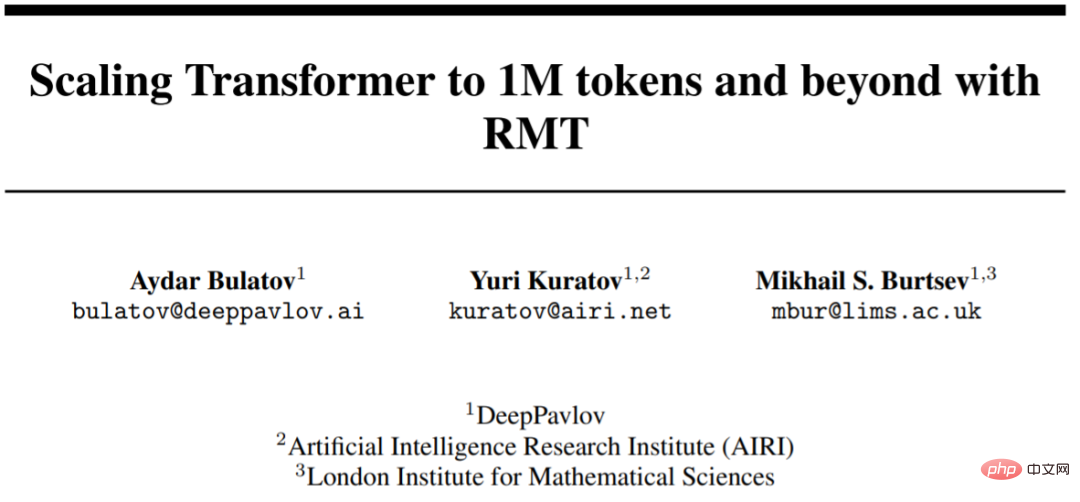
Paper address: https://arxiv.org/pdf/2304.11062.pdf
However, some people have reminded that this is not a real "free lunch". The improvement of the above-mentioned papers is obtained by "longer reasoning time and substantial decrease in quality". . Therefore, it is not yet a revolution, but it may become the basis for the next paradigm (tokens may be infinitely long).
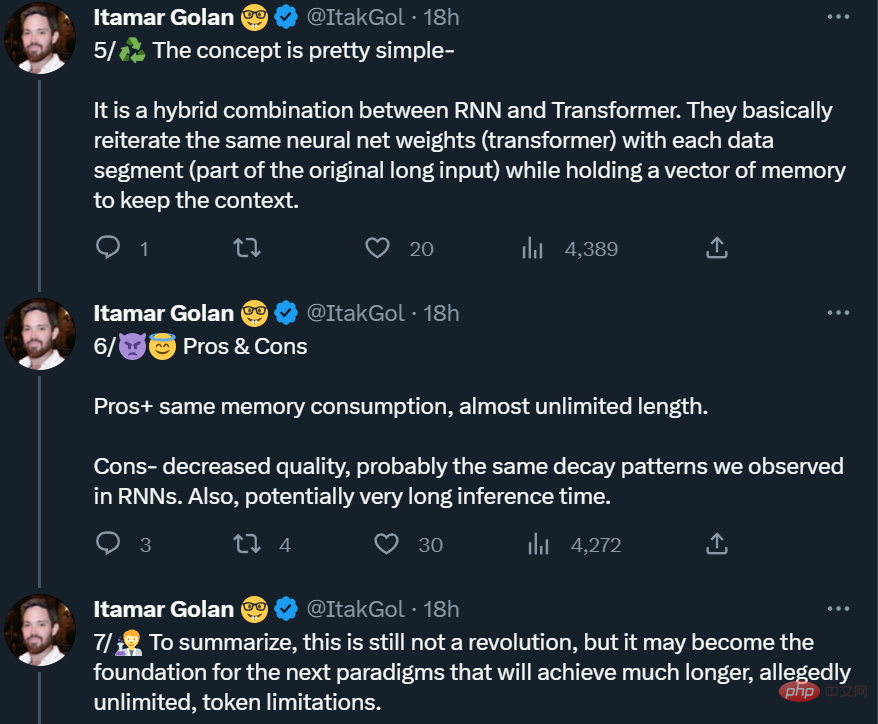
Recurrent Memory Transformer
This study adopts the method Recurrent Memory Transformer proposed by Bulatov et al. in 2022 (RMT) and change it to a plug-and-play method. The main mechanism is as shown in the figure below:

Long input is split into multiple segments, and a memory vector is added before the first segment embedding and processed together with the segment token. For pure encoder models like BERT, the memory is only added once at the beginning of the segment, unlike (Bulatov et al., 2022), where the pure decoder model divides the memory into read and write parts. For time step τ and segment

, the loop executes as follows:

Where, N is the number of layers of Transformer. After forward propagation,

# contains the updated memory token of segment τ.
The segments of the input sequence are processed in order. To enable circular connections, the study passes the output of the memory token from the current segment to the input of the next segment:

Both memory and looping in RMT are based only on global memory tokens. This allows the backbone Transformer to remain unchanged, making RMT's memory enhancement capabilities compatible with any Transformer model.
Computational efficiency
This study estimates the FLOPs required for RMT and Transformer models of different sizes and sequence lengths .
As shown in Figure 3 below, if the length of the segment is fixed, RMT can scale linearly for any model size. This study achieves linear scaling by dividing the input sequence into segments and computing the complete attention matrix only within segment boundaries.
Due to the high computational complexity of the FFN layer, larger Transformer models tend to exhibit slower quadratic scaling with sequence length. However, for very long sequences larger than 32000, they fall back to quadratic expansion. For sequences with more than one segment (> 512 in this study), RMT requires fewer FLOPs than acyclic models and can reduce the number of FLOPs by up to 295 times. RMT provides a greater relative reduction in FLOP for smaller models, but the 29x reduction in FLOP for the OPT-175B model is significant in absolute terms.
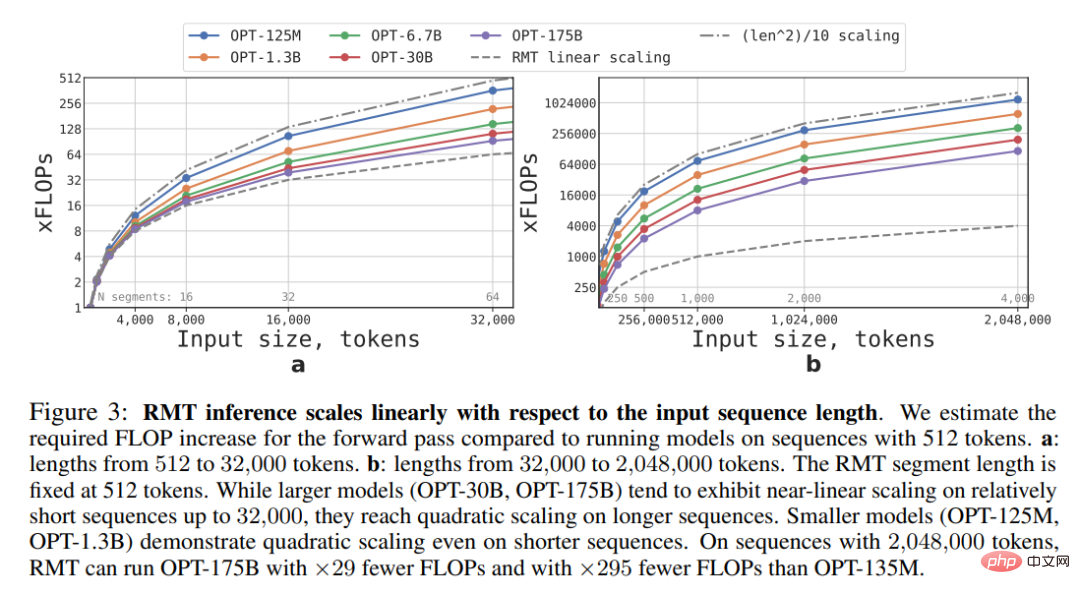
Memory Task
To test memory abilities, the study constructed synthetic datasets that required memorization of simple facts and basic reasoning. Task input consists of one or more facts and a question that can only be answered using all the facts. To increase the difficulty of the task, the study also added natural language text unrelated to the question or answer to act as noise, so the model was tasked with separating facts from irrelevant text and using the facts to answer the question.

Fact memory
First item The task is to test RMT's ability to write and store information in memory for long periods of time, as shown at the top of Figure 4 below. In the simplest case, the facts tend to be at the beginning of the input, and the questions are always at the end. The amount of irrelevant text between questions and answers gradually increases to the point where the entire input does not fit into a single model input.

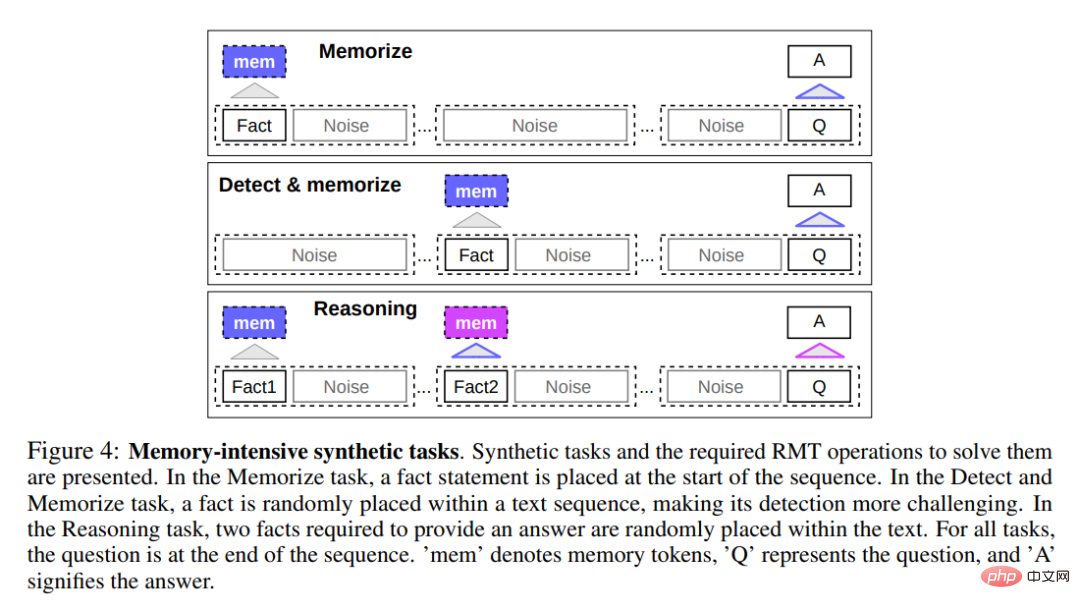
##Fact Detection and Memory
Fact detection increases the difficulty of the task by moving a fact to a random position in the input, as shown in the middle of Figure 4 above. This requires the model to first distinguish the fact from irrelevant text, write the fact into memory, and then use it to answer the question at the end.
Using memorized facts to reason
Another operation of memory is to reason using memorized facts and the current context. To evaluate this functionality, the researchers used a more complex task in which two facts were generated and placed within an input sequence, as shown at the bottom of Figure 4 above. The question asked at the end of the sequence is described in such a way that arbitrary facts must be used to answer the question correctly.

Experimental results
The researchers used 4 to 8 NVIDIA 1080ti GPUs to train and evaluate the model . For longer sequences, they used a single 40GB NVIDIA A100 to speed up evaluation.
Course Learning
The researchers observed that using the training plan can significantly improve the accuracy and accuracy of the solutions. stability. Initially, RMT is trained on a shorter version of the task and increases the task length by adding another segment as the training converges. The course learning process continues until the required input length is reached.
In the experiment, the researchers first started with a sequence suitable for a single segment. The actual segment size is 499, but due to BERT's 3 special tokens and 10 memory placeholders retained from the model input, the size is 512. They note that after training on a shorter task, RMT is easier to solve longer versions of the task, thanks to the fact that it uses fewer training steps to converge to a perfect solution.
Extrapolation ability
What is the generalization ability of RMT to different sequence lengths? To answer this question, the researchers evaluated models trained on different numbers of segments to solve longer tasks, as shown in Figure 5 below.
They observed that models tend to perform better on shorter tasks, with the only exception being the single-segment inference task, which becomes Very difficult to solve. One possible explanation is that because the task size exceeds one segment, the model no longer "expects" problems in the first segment, resulting in a decrease in quality.
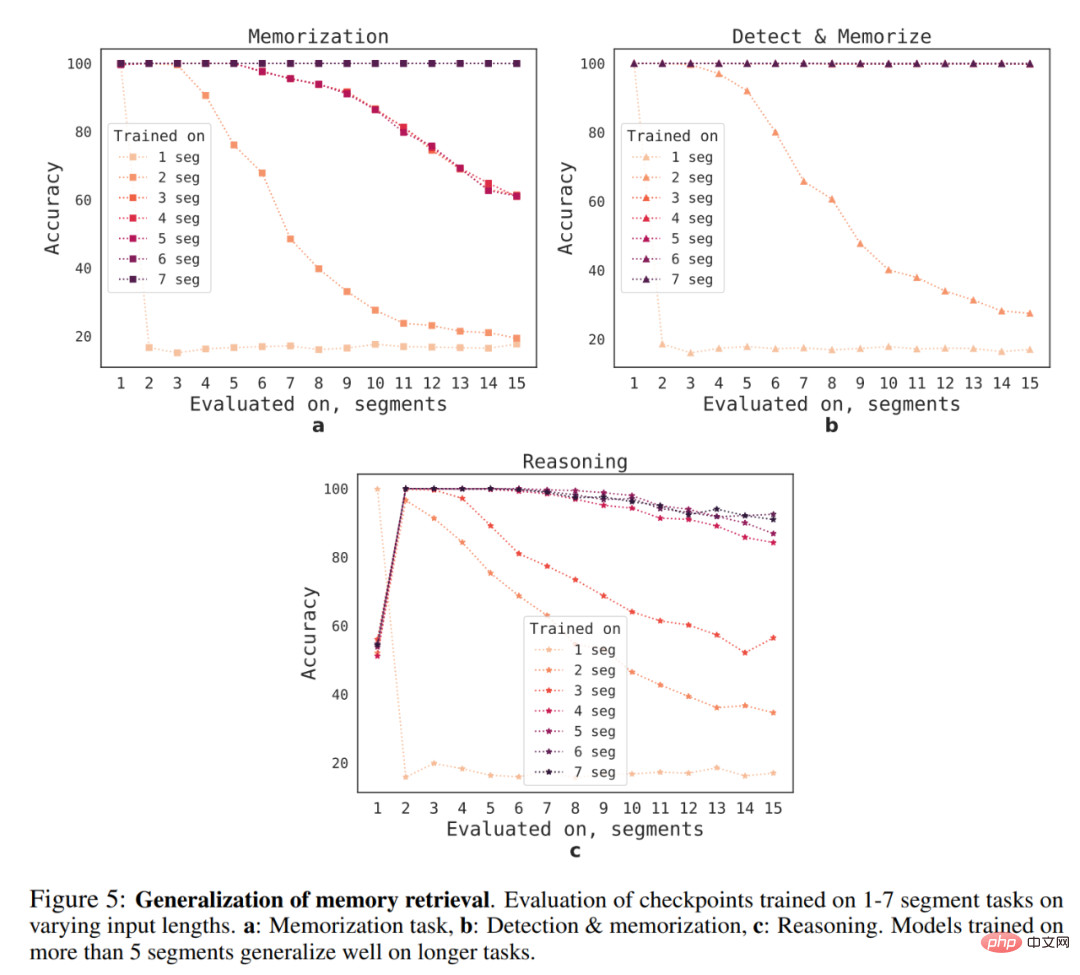
Interestingly, RMT’s ability to generalize to longer sequences also appears as the number of training segments increases. After training on 5 or more segments, RMT can generalize nearly perfectly to tasks twice as long.
In order to test the limitations of generalization, the researchers increased the verification task size to 4096 segments or 2,043,904 tokens (as shown in Figure 1 above). RMT performed on such a long sequence Performed surprisingly well. Detection and memory tasks are the simplest, and reasoning tasks are the most complex.
Attention pattern of memory operations
In Figure 6 below, by examining the RMT attention on a specific segment, the researcher observed that the memory operation corresponds to specific attention. model. Furthermore, the high extrapolation performance on extremely long sequences in Section 5.2 demonstrates the effectiveness of the learned memory operations, even when used thousands of times.

Please refer to the original paper for more technical and experimental details.
The above is the detailed content of True Quantum Speed Reading: Breaking through the limit of GPT-4 that can only understand 50 pages of text at a time, new research extends to millions of tokens. For more information, please follow other related articles on the PHP Chinese website!

Hot AI Tools

Undresser.AI Undress
AI-powered app for creating realistic nude photos

AI Clothes Remover
Online AI tool for removing clothes from photos.

Undress AI Tool
Undress images for free

Clothoff.io
AI clothes remover

AI Hentai Generator
Generate AI Hentai for free.

Hot Article

Hot Tools

Notepad++7.3.1
Easy-to-use and free code editor

SublimeText3 Chinese version
Chinese version, very easy to use

Zend Studio 13.0.1
Powerful PHP integrated development environment

Dreamweaver CS6
Visual web development tools

SublimeText3 Mac version
God-level code editing software (SublimeText3)

Hot Topics
 1386
1386
 52
52
 How to define header files for vscode
Apr 15, 2025 pm 09:09 PM
How to define header files for vscode
Apr 15, 2025 pm 09:09 PM
How to define header files using Visual Studio Code? Create a header file and declare symbols in the header file using the .h or .hpp suffix name (such as classes, functions, variables) Compile the program using the #include directive to include the header file in the source file. The header file will be included and the declared symbols are available.
 Do you use c in visual studio code
Apr 15, 2025 pm 08:03 PM
Do you use c in visual studio code
Apr 15, 2025 pm 08:03 PM
Writing C in VS Code is not only feasible, but also efficient and elegant. The key is to install the excellent C/C extension, which provides functions such as code completion, syntax highlighting, and debugging. VS Code's debugging capabilities help you quickly locate bugs, while printf output is an old-fashioned but effective debugging method. In addition, when dynamic memory allocation, the return value should be checked and memory freed to prevent memory leaks, and debugging these issues is convenient in VS Code. Although VS Code cannot directly help with performance optimization, it provides a good development environment for easy analysis of code performance. Good programming habits, readability and maintainability are also crucial. Anyway, VS Code is
 Docker uses yaml
Apr 15, 2025 am 07:21 AM
Docker uses yaml
Apr 15, 2025 am 07:21 AM
YAML is used to configure containers, images, and services for Docker. To configure: For containers, specify the name, image, port, and environment variables in docker-compose.yml. For images, basic images, build commands, and default commands are provided in Dockerfile. For services, set the name, mirror, port, volume, and environment variables in docker-compose.service.yml.
 What underlying technologies does Docker use?
Apr 15, 2025 am 07:09 AM
What underlying technologies does Docker use?
Apr 15, 2025 am 07:09 AM
Docker uses container engines, mirror formats, storage drivers, network models, container orchestration tools, operating system virtualization, and container registry to support its containerization capabilities, providing lightweight, portable and automated application deployment and management.
 What platform Docker uses to manage public images
Apr 15, 2025 am 07:06 AM
What platform Docker uses to manage public images
Apr 15, 2025 am 07:06 AM
The Docker image hosting platform is used to manage and store Docker images, making it easy for developers and users to access and use prebuilt software environments. Common platforms include: Docker Hub: officially maintained by Docker and has a huge mirror library. GitHub Container Registry: Integrates the GitHub ecosystem. Google Container Registry: Hosted by Google Cloud Platform. Amazon Elastic Container Registry: Hosted by AWS. Quay.io: By Red Hat
 What is the docker startup command
Apr 15, 2025 am 06:42 AM
What is the docker startup command
Apr 15, 2025 am 06:42 AM
The command to start the container of Docker is "docker start <Container name or ID>". This command specifies the name or ID of the container to be started and starts the container that is in a stopped state.
 Which one is better, vscode or visual studio
Apr 15, 2025 pm 08:36 PM
Which one is better, vscode or visual studio
Apr 15, 2025 pm 08:36 PM
Depending on the specific needs and project size, choose the most suitable IDE: large projects (especially C#, C) and complex debugging: Visual Studio, which provides powerful debugging capabilities and perfect support for large projects. Small projects, rapid prototyping, low configuration machines: VS Code, lightweight, fast startup speed, low resource utilization, and extremely high scalability. Ultimately, by trying and experiencing VS Code and Visual Studio, you can find the best solution for you. You can even consider using both for the best results.
 Docker application log storage location
Apr 15, 2025 am 06:45 AM
Docker application log storage location
Apr 15, 2025 am 06:45 AM
Docker logs are usually stored in the /var/log directory of the container. To access the log file directly, you need to use the docker inspect command to get the log file path, and then use the cat command to view it. You can also use the docker logs command to view the logs and add the -f flag to continuously receive the logs. When creating a container, you can use the --log-opt flag to specify a custom log path. In addition, logging can be recorded using the log driver, LogAgent, or stdout/stderr.



